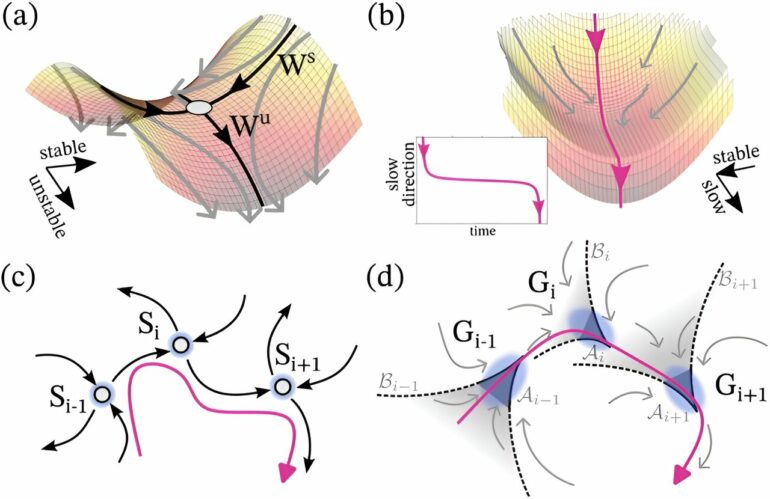Scientists all over the world use modeling approaches to understand complex natural systems such as climate systems or neuronal or biochemical networks. A team of researchers has now developed a new mathematical framework that explains, for the first time, a mechanism behind long transient behaviors in complex systems.
They introduce ghost channels and ghost cycles as novel objects that explain how natural systems can be stable over prolonged periods of time, yet still be able to rapidly switch to another state.
This new approach challenges the traditional concept based on stable or unstable equilibria and might help us to better understand how transiently-stable neuronal dynamics governs sensory information processing, or how to potentially predict tipping cascades, such as those driving the loss of biodiversity.
The joint study by the Max Planck Institute for Neurobiology of Behavior—caesar, the University of Leicester, and King’s College London has been published in the journal Physical Review Letters.
When you find yourself in a new city and ask for directions, your working memory temporarily holds chunks of information such as turns or landmarks, that you follow in a specific sequence. Once you make it to your destination though, you will forget about the details. In order to perform this task, the neuronal networks in your brain have the opposed abilities to transiently stabilize neuronal activity in order to remember information, but also to quickly switch to a different state in the sequence.
Similar dynamics can also be observed in ecology. In competing microbial populations, one species often dominates for a long time and appears to define a stable equilibrium when suddenly, for no apparent reason, another species starts to take over, leading to a decline of the previous species. Such transitions can even lead to extinctions and biodiversity loss.
In order to predict whether and when such a tipping event might happen, the observed dynamics before the shift are often analyzed. The difficulty with such predictions is that they require prior knowledge about whether the state is indeed stable or comes from a long transient, to successfully interpret the statistics of the recorded data.
However, for economically important ecosystems such as coral reefs, it is necessary to identify whether reefs that appear to be a healthy ecosystem may in fact be in danger of tipping into a degraded algae-dominated state.
Challenging traditional dynamics models
Classically, dynamical states of any complex system have been described as attractors, or equilibria—abstract mathematical objects expected to be observed for an infinitely long period of time and where the system returns to after a small perturbation. These states, however, do not capture how transient stability, as well as rapid transitions can be achieved.
To introduce both features, sequences of dynamical saddles have been previously considered. Akin to the shape of a saddle, it stabilizes the dynamics along one dimension—along the seat, but is intrinsically unstable and can fall off along the orthogonal dimension.
Therefore, if the unstable dimension of one is connected to the stable dimension of another saddle, a channel of saddles, called a heteroclinic channel, can emerge, such that the dynamics of the systems can switch between states in a sequence.
In a study led by scientists of the Max Planck Institute for Neurobiology of Behavior in Bonn (MPINB), in collaboration with researchers from the University of Leicester, and King’s College London, the team has now shown that heteroclinic channels cannot fully capture the dynamics observed in real-world, noisy systems. The capability to generate transiently stable states along the saddle is lost as soon as the system encounters even small perturbations.
In contrast, they have identified special types of instabilities, called ghost channels and ghost cycles, explaining how complex systems can display robust transiently stable behavior, after which they would quickly transition to another transiently stable state that can have very different properties.
The ghost structures are a feature that emerges at criticality, when a system is balanced at the boundary between two or more qualitatively different regimes. Such organization allows systems to exploit qualitatively different regimes, and thereby also effectively balance between opposed features.
Dr. Akhilesh Nandan from MPINB explains, “Changing the framework that the dynamics are governed by stable states, or attractors, to a framework where the dynamics are dictated by formally unstable structures such as ghost-based scaffolds, enabled us to obtain a potential description for what has been experimentally observed across broad range of systems. Crucial for defining this framework was the mathematical characterization of these abstract ghost objects.”
Understanding degrading ecosystems or climate change
In their publication, the scientists demonstrate that ghost-based scaffolds better capture the properties of long transients in noisy systems compared to traditional models. Instead of relying on precise knowledge or the existence of (un)stable fixed points, this novel framework centers on slow directed flows organized by ghost sets in ghost channels and ghost cycles.
An exciting implication from this study is that ghost structures seem to underline many different processes across biological and natural systems once you know what to look for.
“We have identified ghost channels in models relevant for cell fate decisions during development, but also models of tipping cascades in climate systems that are used to explore how tipping, e.g., of the Atlantic Meridional Overturning Circulation (AMOC) could affect the dynamics of other climate sub-systems,” says Dr. Daniel Koch.
Therefore, these new findings open many doors for future research, from a theoretical understanding of how neuronal networks encode smell or taste, to a potentially better prediction of shifts in ecosystems or the climate.
“What we are most excited about, however, is the potential this powerful theoretical framework can bring for biological and artificial intelligence research,” says Dr. Aneta Koseska, who leads the group of Cellular Computations and Learning at the MPINB in Bonn. “We already started investigating how ghost scaffolds can aid learning of natural and artificial neuronal networks, and use them to overcome the current obstacles of catastrophic forgetting.”
This framework, therefore, could possibly provide a potential umbrella to study long transients, but also to identify the limits of the current mathematical frameworks and where further expansions are necessary to tackle long-standing open questions of quasi-stable transient dynamics across living, natural and man-made systems.
More information:
D. Koch et al, Ghost Channels and Ghost Cycles Guiding Long Transients in Dynamical Systems, Physical Review Letters (2024). DOI: 10.1103/PhysRevLett.133.047202
Provided by
Max Planck Society
Citation:
Balancing instability and robustness: New mathematical framework for dynamics of natural systems (2024, July 26)



